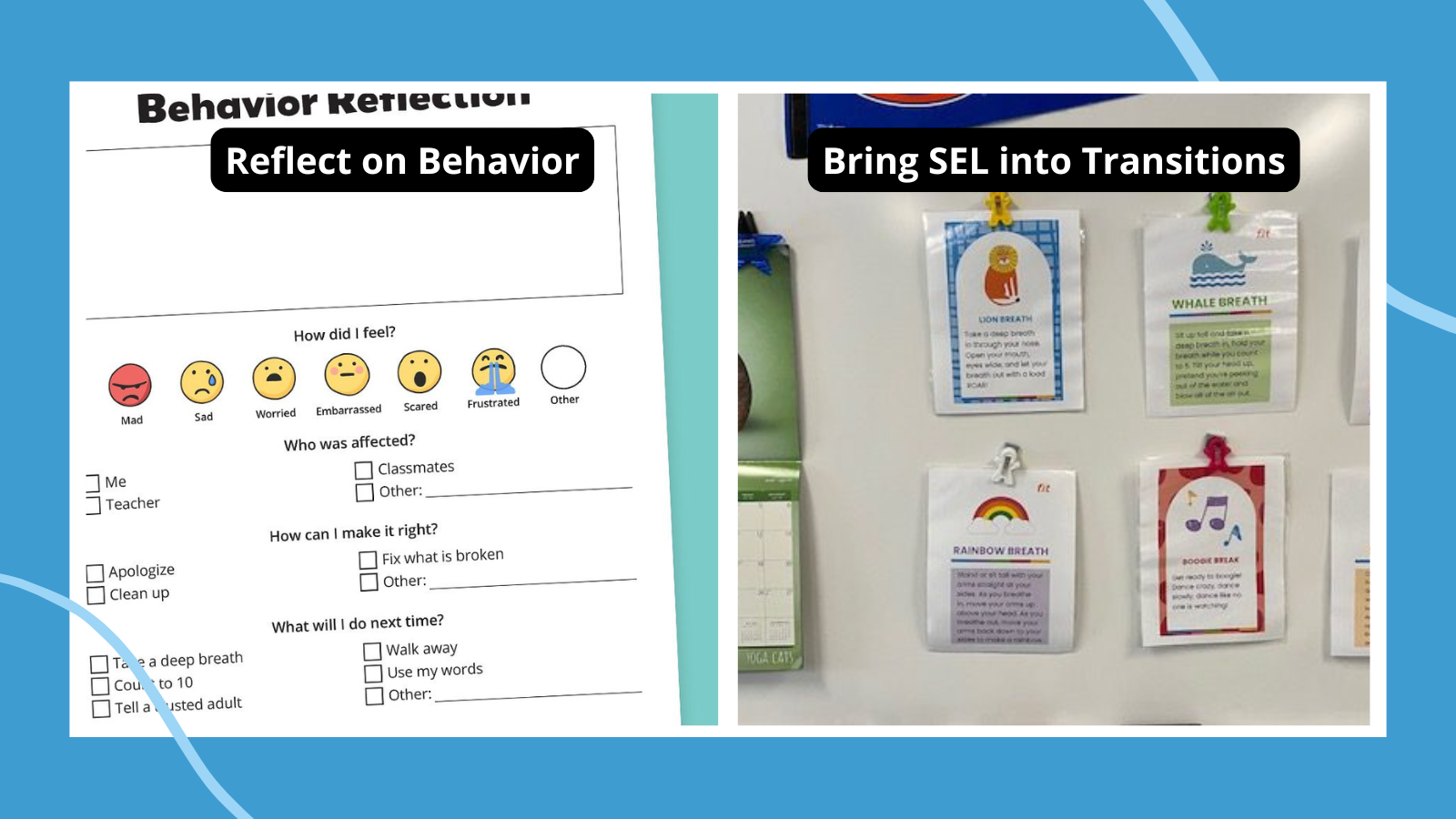In addition to all the reading, writing, and arithmetic that students learn in school, they’re also learning social-emotional, or SEL, skills. Social-emotional skills include self-management, self-awareness, social awareness, relationship building, and decision-making. Whether or not your school uses an SEL curriculum, you can incorporate SEL skills throughout the day with activities that help students think about feelings, build relationships, resolve conflict, and make good decisions. Here are our favorite social-emotional learning activities to incorporate into your school day. There are ideas for preschool through high school, because SEL skills are skills you never stop learning!
Learn more: What is social-emotional learning?
1. Reference an emotions bulletin board
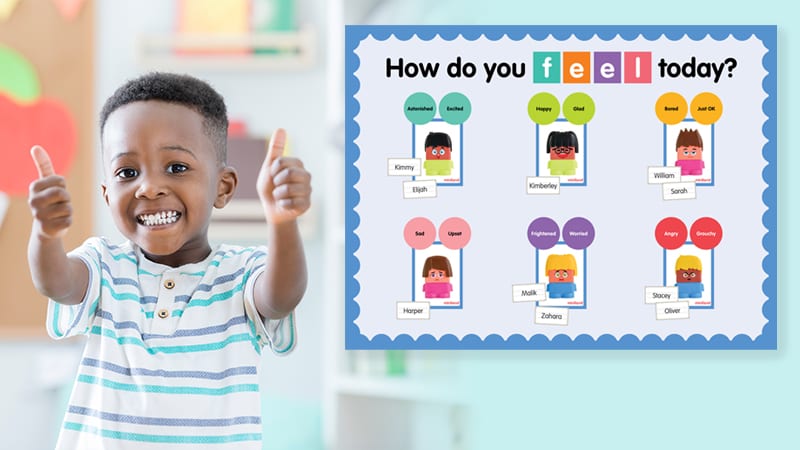
Little kids have big feelings, and they need to learn the words to match their emotions. Use this free bulletin board kit to create a reference for students as they’re learning feelings. You can use it for a number of social-emotional learning activities. Have students identify the way they are feeling during morning meeting. Or for older students, use the bulletin board to name feelings and synonyms for various feelings. You can also have students refer to the bulletin board when they are analyzing literature and characters’ feelings.
Learn more: Free Printable Emotions Bulletin Board Kit
2. Start the day with a greeting

Start the day at your classroom door greeting each student. Use this greeting sign to give students choice in how they greet you each day. A daily greeting starts the day off on a positive note and gives you a quick check-in with each student. Kindergartners may want to tell you all about their weekend, while you may notice that a high schooler is looking stressed.
Learn more: Free Printable Classroom Greeting Sign
3. Use a feelings chart
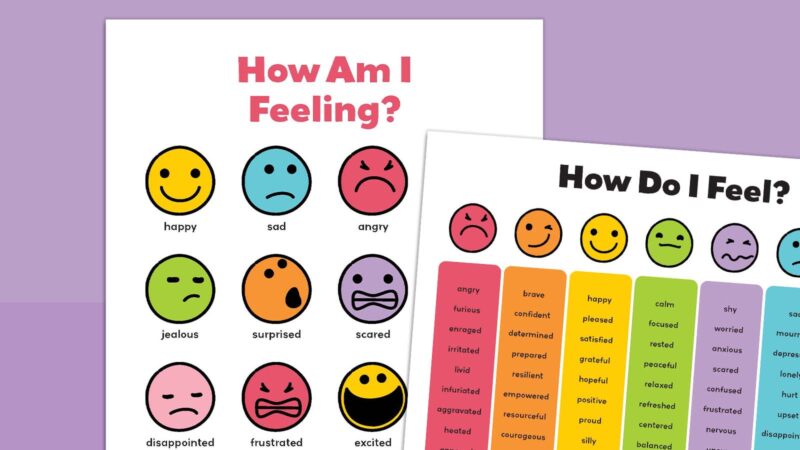
Talk about feelings on the regular. Use this feelings bundle for various social-emotional learning activities. You can incorporate a feelings check in each day with younger students and provide older students with all the words they need to describe their feelings in a journal prompt. The more practice students have at expressing their feelings, the better they are at managing them.
Learn more: Free Printable Feelings Charts
4. Set a daily mindfulness routine
At the start of a lesson or day, take a few minutes for mindfulness. Choose mindfulness activities that match your class. Yoga for a busy bunch, music for older students, or a guided meditation for students who love to visualize a story.
Learn more: Mindfulness Activities for Kids
5. Practice positive affirmations
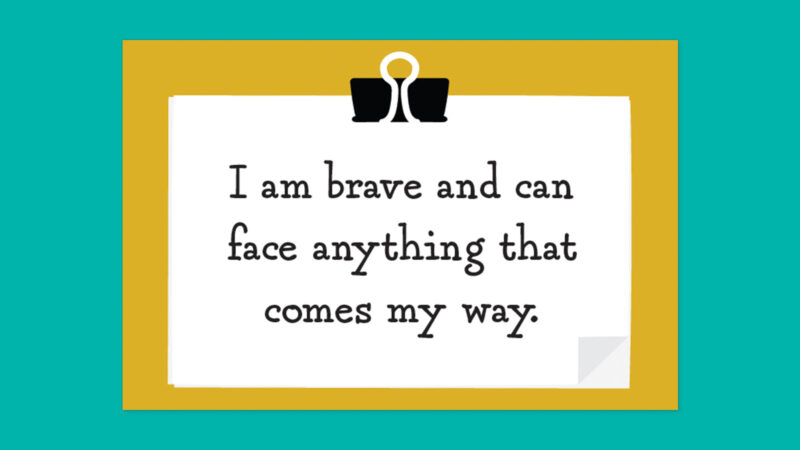
The way students talk to themselves impacts how they persist, feel about their day, and how they interact with others. Use these daily affirmation cards to help students develop positive self-talk. Pass them out at the start of a week and have students reflect on what each statement means to them. Can they incorporate their statement into their internal talk this week? At the end of the week, have them share or write a reflection about how the statement shaped their week.
Learn more: Free Printable Positive Affirmation Cards
6. Get into the habit of journaling
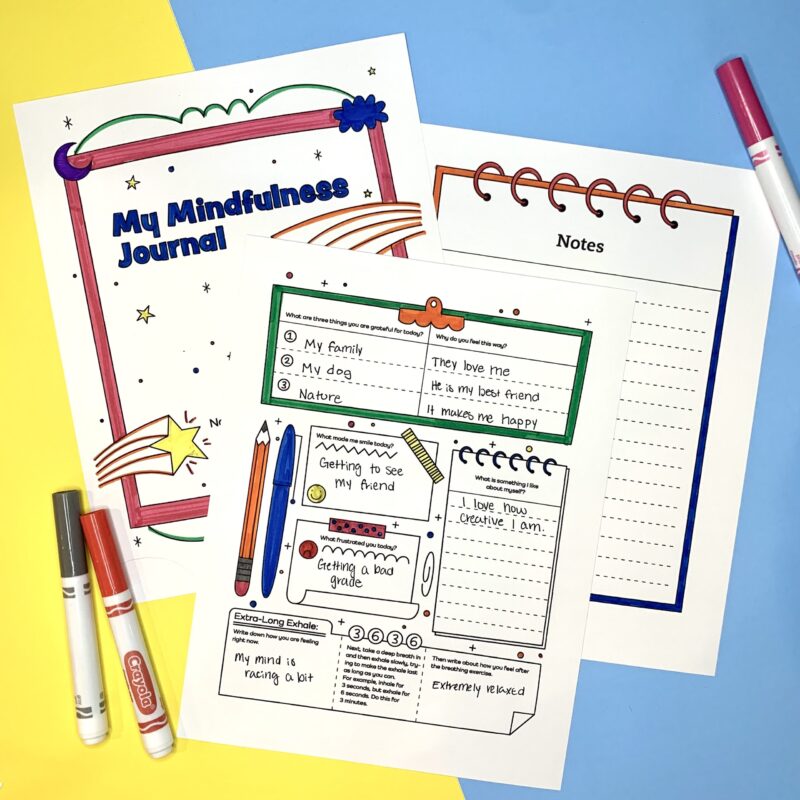
Younger students can get in the habit of writing their thoughts and feelings with weekly journal prompts. Older students can use a mindfulness journal to track how they feel and what they’re thinking across a week, month, or school year.
Learn more: Free Printable Mindfulness Journal
7. Take regular brain breaks
Brain breaks—where you completely set aside academic work and spend time moving, listening, or even being silent—help students reset and get ready for more learning. These social-emotional learning activities are great for students of all ages. Younger students can do a dance or movement break. Older students can color to music for one minute.
8. Use the Worry Iceberg
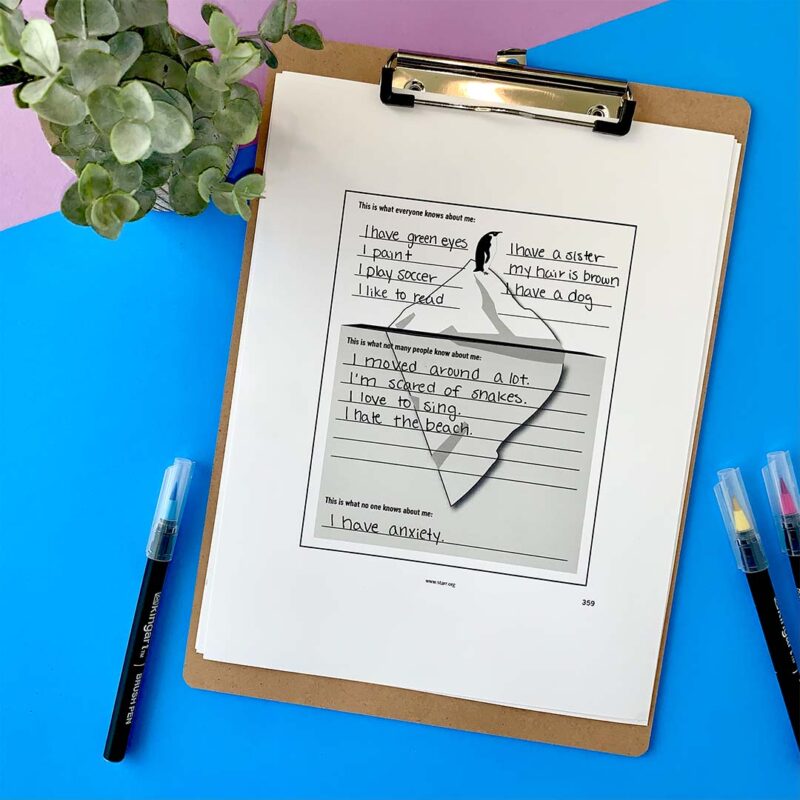
Building emotional resilience includes understanding how first impressions can be incomplete. Help students develop emotional resilience with a Worry Iceberg activity. Have students think about a situation that made them anxious. What could they see? What was also happening underneath? How does knowing the whole “iceberg” help them understand the situation? And what can they do in the future to get the whole “iceberg” when a situation arises?
Learn more: One-Minute Activities To Build Emotional Resilience
9. Maximize transitions for self-awareness
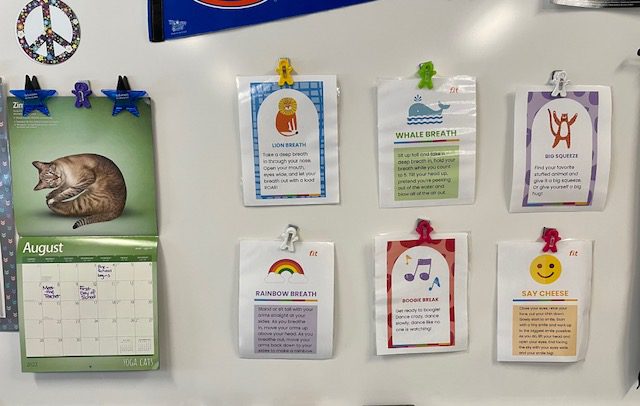
Use transitions as social-emotional learning activities that reinforce self-awareness by having students breathe like an animal, strike a yoga pose, or check in with how they feel.
Learn more: How To Use Transition Times for Emotional Health Check-Ins
10. Introduce the Zones of Regulation
Another way for students to check in with their emotions is using the Zones of Regulation. Students identify their feeling zone using the colors. Once they know their zone, they can identify which strategy to use to get back to green (if they’re not already there).
Learn more: Zones of Regulation Activities
11. Schedule a morning meeting
Morning meeting is an important part of elementary school and provides a time for students to reflect on their feelings and actions, talk about concerns that arise during the day, or engage in collaborative decision-making. Even in the upper grades, a once-a-week 10-minute check-in can serve the same purpose.
12. Teach active listening skills
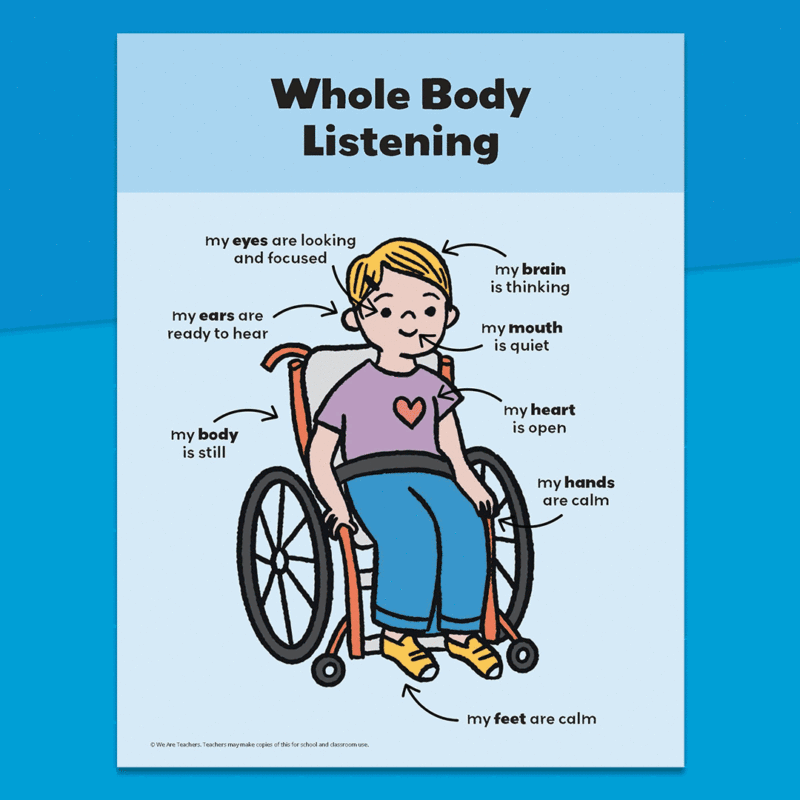
Students are better able to learn, build relationships, and increase social awareness when they’re listening. Teach or reinforce whole body listening so students know what listening looks like, and how to manage their bodies so they understand what others say to them. Note that students with ADHD, autism, and sensory processing challenges may not be able perform whole body listening in the same way other students do, but we can make accommodations for students based on what we know they need to be successful.
Learn more: Free Whole Body Listening Posters and Worksheet
13. Build in behavior reflection
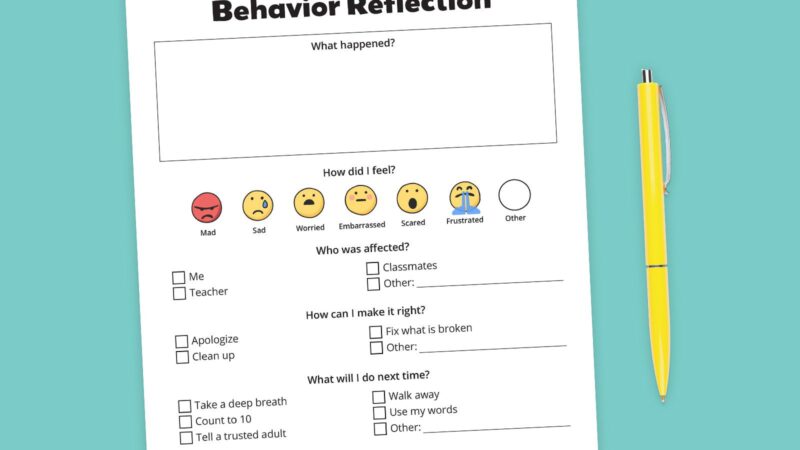
As students develop self-awareness and self-management skills, reflecting on their behaviors is an important step. Use behavior reflection sheets to guide students’ reflection and turn behavior situations into a learning opportunity.
Learn more: Free Printable Behavior Reflection Sheets
14. Create a calm-down corner
A calm-down corner is a space students can go to when they need to calm down. Even going to the calm-down corner when they are overwhelmed or upset shows that students are developing self-awareness and self-management skills. You can include a variety of social-emotional learning activities in your calm-down corner, such as fidgets and breathing exercises.
Learn more: How To Create a Calm-Down Corner in Any Learning Environment
15. Create calm-down jars
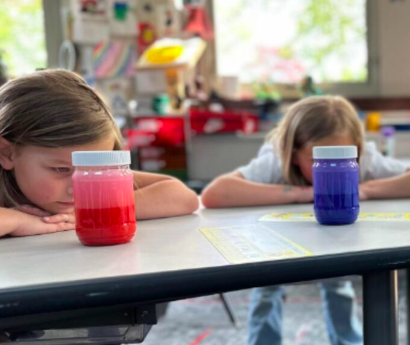
A calm-down strategy that students can take with them, a DIY calming jar is a great craft that you can use to talk about the importance of emotional regulation and self-management.
Learn more: DIY Calm-Down Jars
16. Try calming mind-body exercise worksheets
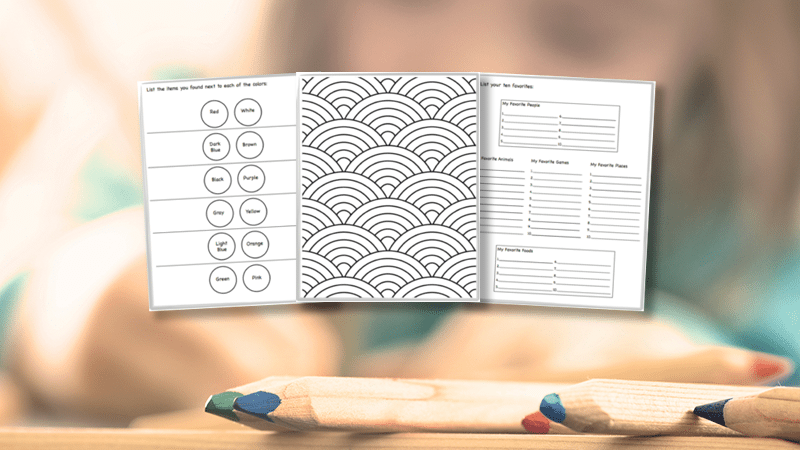
Older students can use meditative exercises, like coloring mandalas or doing guided visualizations. Use a variety of mindfulness exercises so each student can find one that works for them.
Learn more: Calming Mind-Body Exercises To Do With Students
17. Model and practice positive self-talk
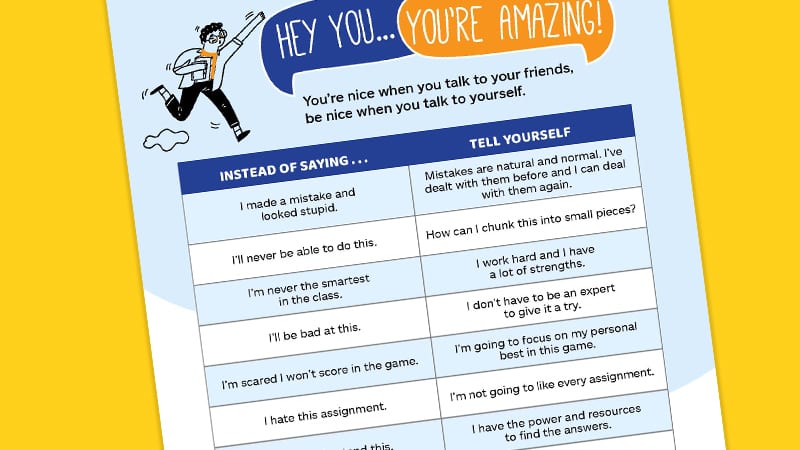
The words students tell themselves impacts their self-management, persistence, and ultimately their success. Model and reinforce positive self-talk with a self-talk poster. Use these phrases when you’re doing think-alouds and prompting students, and encourage them to do the same.
Learn more: Free Printable Positive Self-Talk Poster for Teens
18. Make DIY stress balls
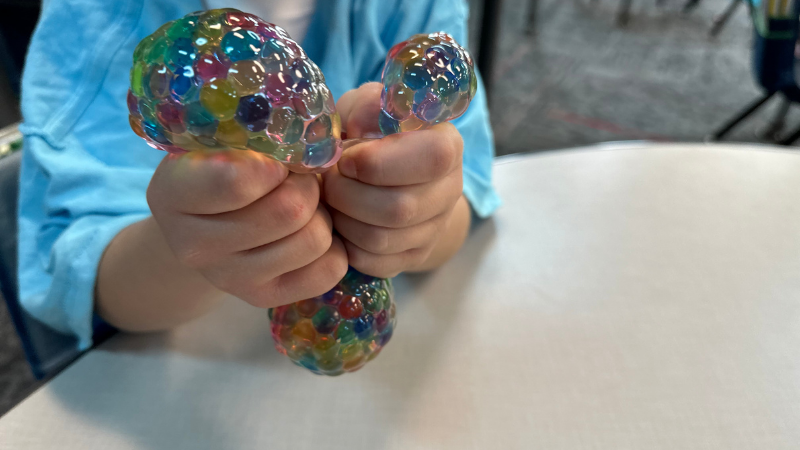
Part classroom craft project, part SEL activity, DIY stress balls are so much fun! Make them using balloons, slime, beads, and more.
Learn more: 4 Different Ways To Make DIY Stress Balls
19. Assign classroom jobs
Classroom jobs build self-management and responsibility skills. While younger students ask for classroom jobs, they’re effective for high schoolers too—the tasks of whiteboard cleaner and technology helper come to mind.
Learn more: The Big List of Classroom Jobs
20. Read SEL stories
A story can be a model for social-emotional skills or it can introduce students to scenarios they haven’t experienced yet. For younger students, read a picture book and talk about what happens and how the characters feel. For older students, read and discuss novels with SEL themes.
Learn more: Best Social Skills Books for Kids
21. Set and track actionable goals
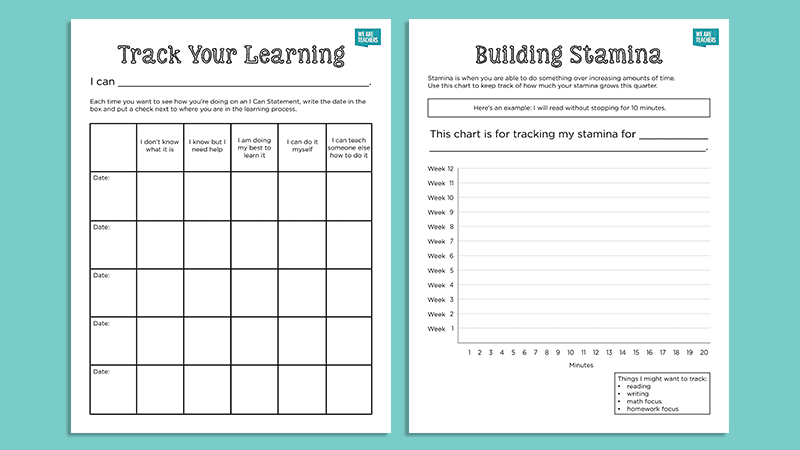
Setting goals contributes to responsibility, but it doesn’t come naturally. We have to teach students how to set meaningful, reasonable targets, and then give them the tools to track their progress. Seeing how they are progressing also helps students build resilience and perspective.
Learn more: Free Printable Back-to-School Goal-Setting page or Goal-Tracking and Stamina worksheets
22. Track important habits
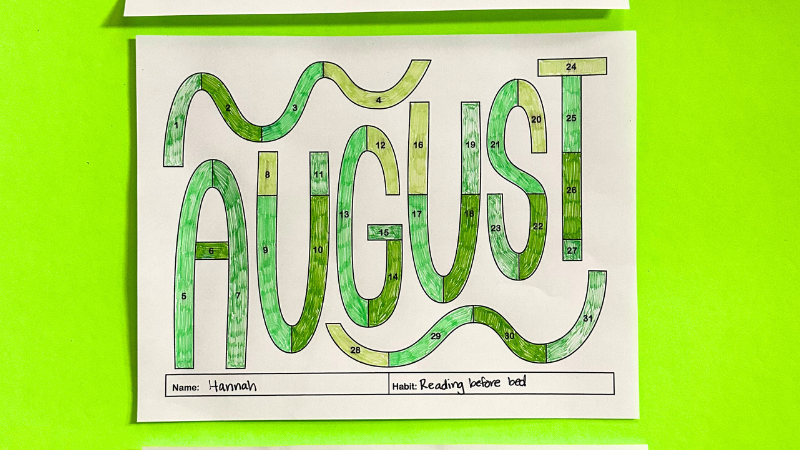
Building new habits takes time and persistence. Use a habit tracker to keep track of how students are progressing toward their goals.
Learn more: Free Habit Tracker Printable Bundle
23. Ask icebreaker questions

Icebreakers are great for the first day of school, but you can actually incorporate them all year long. Use them when you form new project groups, or when you change the seating around in your room. Talking about different topics helps students practice conversation skills.
Learn more: 300 Fun Icebreaker Questions for Kids and Teens
24. Hang kindness posters
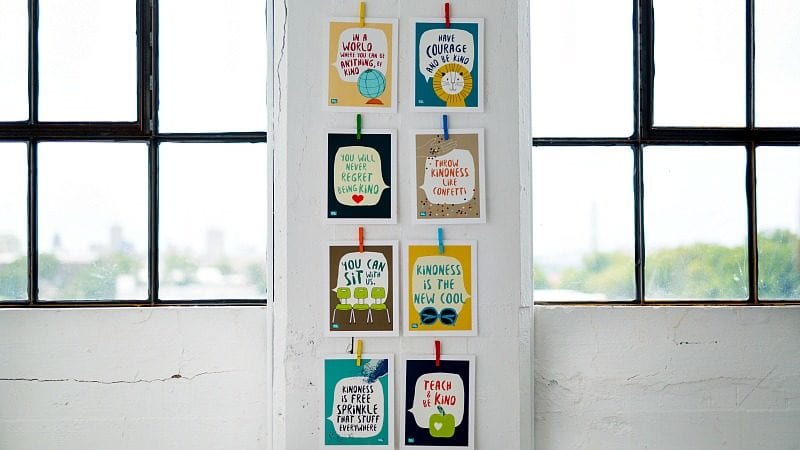
This free set of printable kindness posters helps spread important messages. When you first put them up, take time to discuss them with your students. Ask them for examples of what kindness looks like, and encourage them to share stories of a time when their kindness made a difference.
Learn more: Free Printable Kindness Posters
25. Use social stories
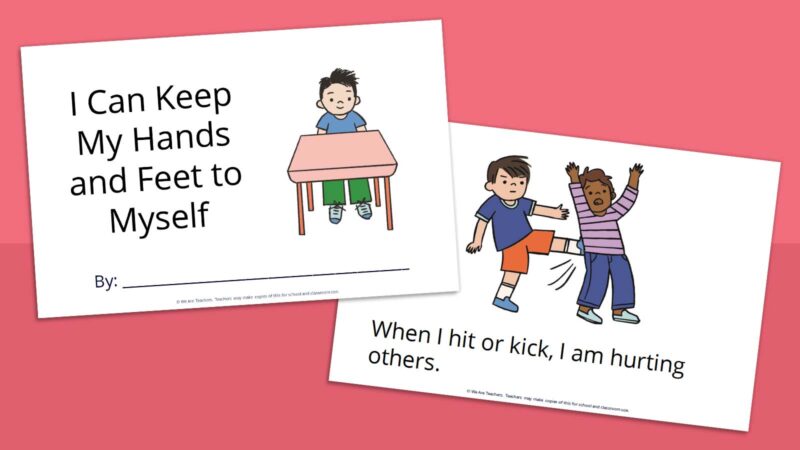
For young students, and students with disabilities who require explicit instruction in social skills, a social story is a great way to teach them step-by-step approaches for social situations. For all students, social stories can help develop social awareness.
Learn more: Free Printable Social Stories for Kids
26. Teach students to be upstanders
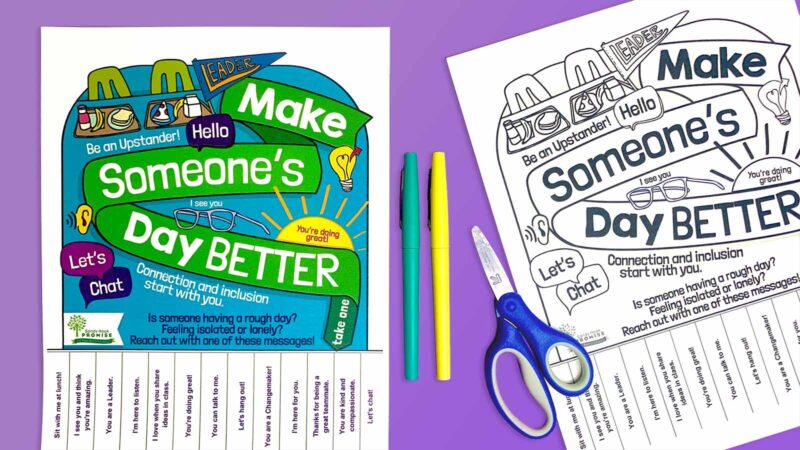
Upstanders reach out to others, especially those who seem like they might be hurting or struggling. Teach kids about the concept, their role in helping build classroom community and helping those who might not feel included, and hang these free printable upstander posters in your classroom. The tear tags offer positive affirmations.
Learn more: Free Printable Take-One Posters
27. Celebrate students’ diversity

Understanding diversity is important for self-awareness and relationship building. Engage students in thinking about how they are unique and how our diversity makes us stronger.
Learn more: Diversity and Inclusion Free Printable Activities
28. Use videos to teach relationship building
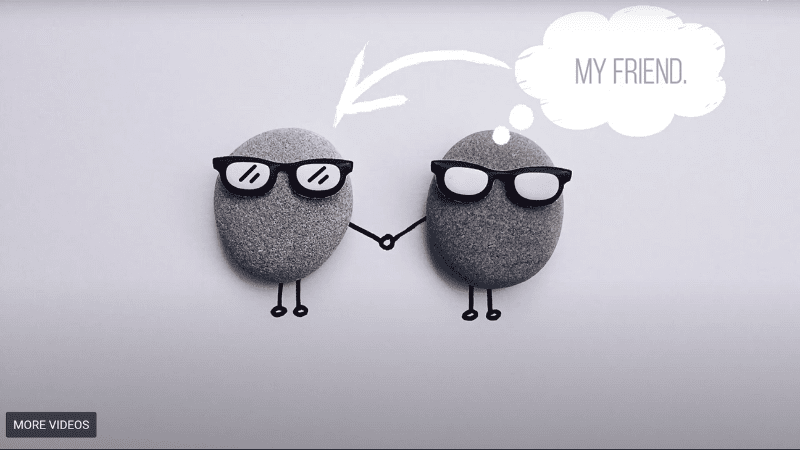
Everyone can use a reminder about how to make and keep friends. Use friendship videos in morning meeting to talk about how to make and keep friends. Or, with older students, use them as a friendly and funny reminder of what students likely already know but might not be practicing. As students learn more about relationships, use anti-bullying videos to start a conversation about this topic.
Learn more: Friendship Videos To Teach Kindness and Compassion and Best Anti-Bullying Videos
29. Practice empathy with scenarios

Help students understand and work through common scenarios that engage their empathy as they think about the scenario, how they would feel, and what they would do.
Learn more: Empathy Prompts
30. Use Band-Aids to learn about fairness
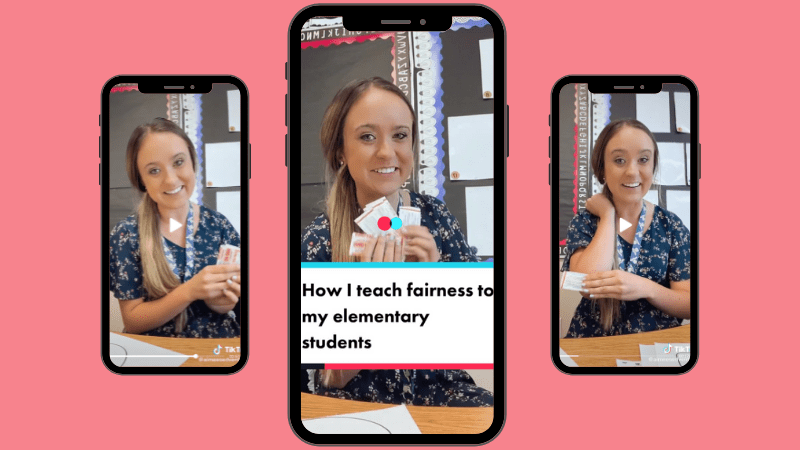
Tired of hearing kids whine, “But that’s not fair!”? Build students’ social awareness with teacher Aimee Scott’s fairness lesson. Her quick and simple exercise helps kids understand that fairness doesn’t mean everyone gets the same thing—it means everyone gets what they need to be successful.
Learn more: The Band-Aid Lesson
31. Play a cooperative game
Kids get plenty of exposure to healthy (and unhealthy) competition, so use classroom time to shift the focus to cooperation instead. Cooperative games encourage kids to communicate, collaborate, and problem-solve together. Point out the skills they’re using during the cooperative games that will help them in relationships as well.
Learn more: Cooperative Games To Promote Comradery and Healthy Competition
32. Create collaborative art
Art is about expressing your individuality, but you can also make something pretty incredible when people pool their talents. Murals, hallway and bathroom displays, kindness rock gardens, and other art projects bring students together to bond over creativity and artistic vision.
Learn more: Collaborative Art Projects
33. Engage in fishbowl discussions
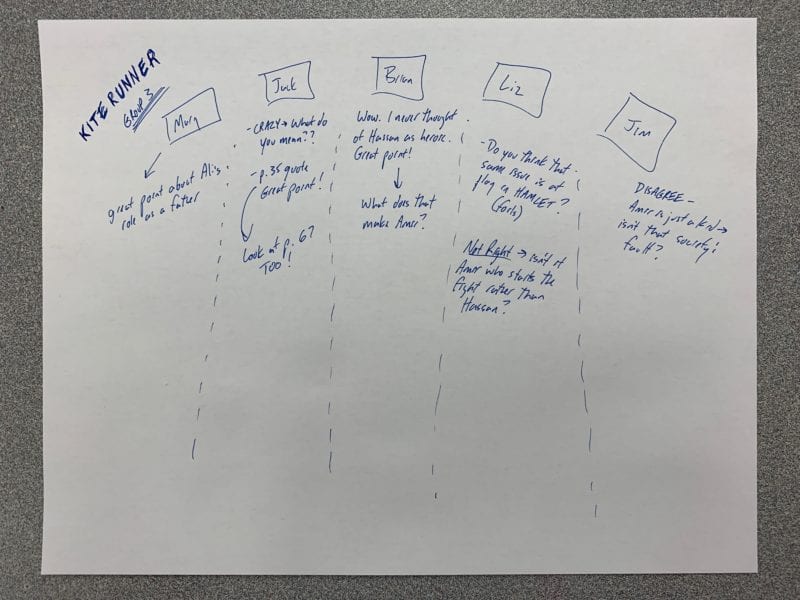
Encourage active listening and communication skills with this classroom idea. After taking some time to think about a topic, a small group of students discusses the issue while other students watch and take notes. After a time, the teacher opens the discussion to the entire group, using notes they made while they watched the small-group discussion.
Learn more: How I Use Fishbowl Discussions To Engage Every Student
34. Sticky-note discussions
Teacher Erin Castillo popularized this concept on her Instagram account, and now teachers everywhere use this idea. We love it as a unique way to take attendance or as a bell-ringer/entry activity. All you do is post a question on your whiteboard and ask students to respond (anonymously or with names attached) using sticky notes. You can use “Would You Rather” questions, or try these SEL prompts to really get students thinking and sharing.
35. Play board games
Whether kids are playing to win or working together to achieve a common goal, board games teach lots of decision-making skills. Players have to analyze information, consider their options, and imagine the impacts of their moves on themselves and others.
Learn more: Best Board Games and Other Games
36. Discuss philosophical questions
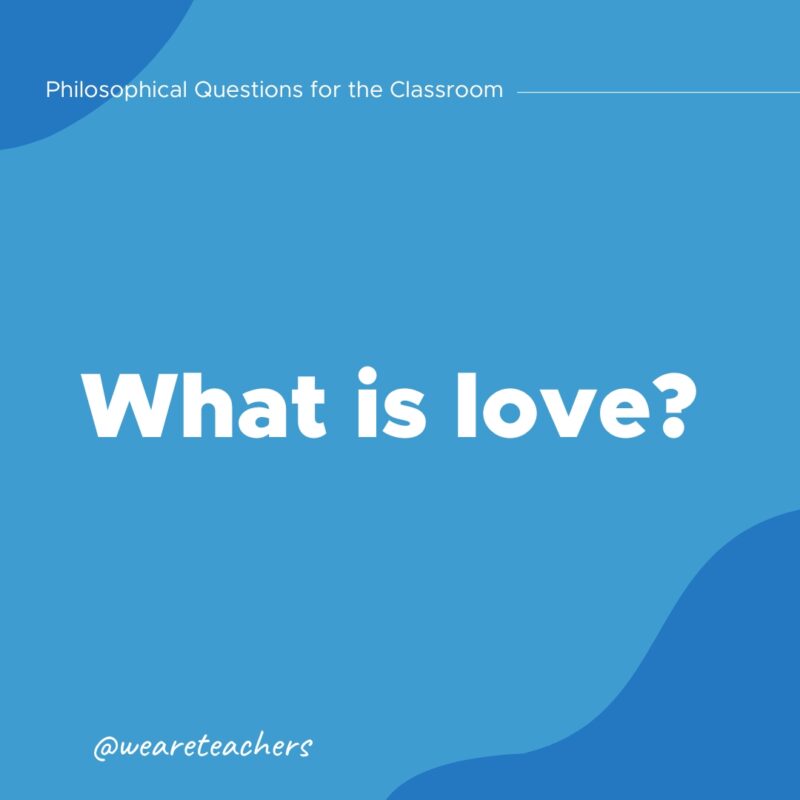
One of the most incredible ways to encourage critical thinking and self-exploration is to ask kids thought-provoking questions. Hearing the responses and exchanging ideas can really expand our perspectives and leave us with important food for thought.
Learn more: Philosophical Questions for Kids and Teens
37. Get a classroom pet
Want to teach kids about responsibility in an incredibly meaningful way? A class pet could be the answer! When kids work together to care for a hamster, goldfish, lizard, or tarantula(!), they have to make responsible choices about what’s best for the animal. Sure, it’s a challenge for the adults involved, but the benefits can really add up.
Learn more: Best Classroom Pets According to Teachers
38. Set up an escape room
Students love the interactivity of an escape room, where they have to work together to solve a series of problems before their time is up. Escape rooms encourage a lot of responsible decision-making skills, both individually and as a group.
Learn more: How To Set Up and Run a Classroom Escape Room
39. Use choice boards
If we want kids to make smart decisions, we’ve got to give them the chance to make choices on their own. One way to do this in the classroom is using choice boards. These interactive tools give kids several options to choose from on an assignment. They can evaluate the possibilities, and choose the one that seems right to them.
Learn more: How I Use Choice Boards To Increase Student Engagement
40. Teach safe online decision-making
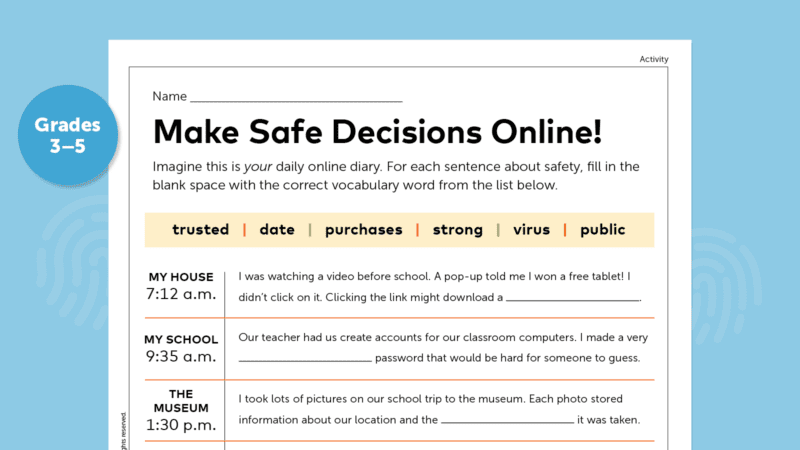
Let’s face it: Kids and teens aren’t necessarily focusing much on safety—their own or anyone else’s. So it’s important for the adults in their lives to help them learn why safe choices matter and what they look like to begin with. We’ve got resources for talking to students about prescription drug safety, Internet safety, bike safety, underage drinking, and inclusive sex ed.
41. Play Dungeons & Dragons
Dungeons & Dragons (D&D) can be a fantastic classroom game, and it encompasses a wide range of social-emotional learning activities. Players need to work together, know their own strengths and weaknesses, make smart choices, and so much more.
Learn more: Teachers Are Using D&D To Teach SEL Skills
42. Talk about tough topics
School shootings, racially motivated violence, abortion, gun control—these are topics most teachers tend to shy away from in the classroom. The thing is, kids need a safe place to talk about these issues. They need adults who will help them sort out their thinking and separate fact from opinion. Students need to learn to respectfully disagree with one another and how to have constructive conversations that may lead to compromise.
Learn more: Our Students Want To Talk About Tough Topics
43. Read the news as a class
If you’re going to make smart decisions, you need to be informed. But many kids only learn about the news and current events from single news sources, usually whatever’s playing on their TV at home. Show students how to find a variety of sources to learn about current events. Teach them to think critically and evaluate articles to separate provable facts from opinion. Many teachers love using Newsela, since the articles can be differentiated for different reading levels.
Learn more: Ways To Use Newsela With Your Students
44. Have students reflect while they work
As students are working on math problems, have them jot down how they’re feeling at each step of the process. They can jot down emojis or words that show where they were confident, confused, distracted, or frustrated. This can be helpful when reviewing work and thinking about how their emotional state impacted their learning.
45. Get inspired by SEL heroes
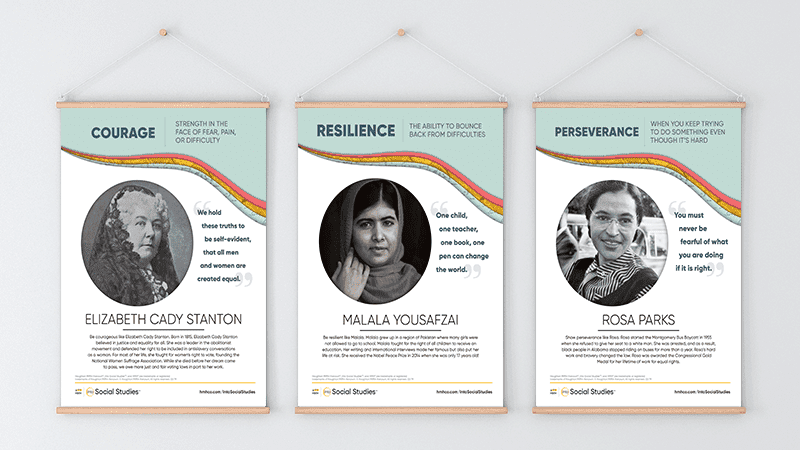
History is full of role models that students can learn from. Use these free character education posters to talk about the qualities you want students to emulate and how they’ve helped others in history. Assign students an SEL hero to research and present about so students can see how others have used SEL skills to change the world.
Learn more: Character Education Posters
46. SEL superpowers
As students learn about social-emotional skills, encourage them to think about their SEL superpower, or the skills they are best at. Once students have identified their superpower, talk about how they can use their SEL superpowers to help others. To share your superpowers, draw superheroes, put students’ pictures on each one, and write about your SEL superpowers and how your students use them around school.
47. Get in the habit of gratitude
Use a bullet journal or list to reinforce gratitude. In younger classrooms, have students call out the things they are grateful for and create a class list. With older students, spend the last five minutes of each class or week reflecting on what they are grateful for.
Learn more: Bullet Journal Ideas
48. Send home an SEL progress report
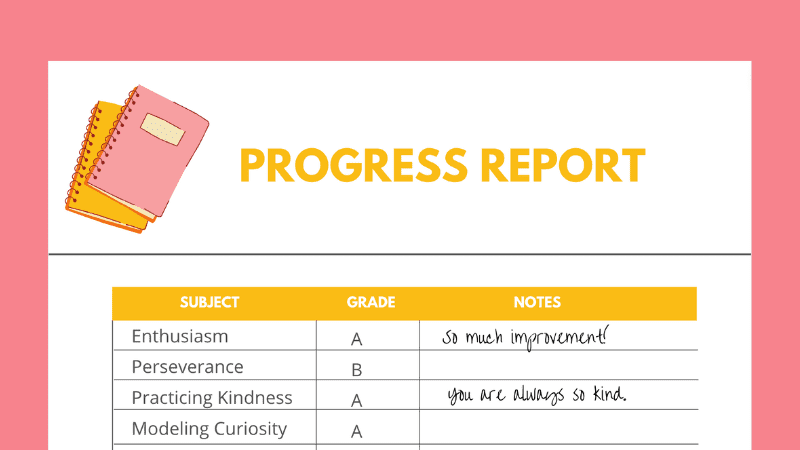
We love the idea of giving kids and their families feedback on their SEL skill development! An alternative progress report like the one this teacher uses can help kids zero in on their strengths and weaknesses.
Learn more: SEL Progress Report

